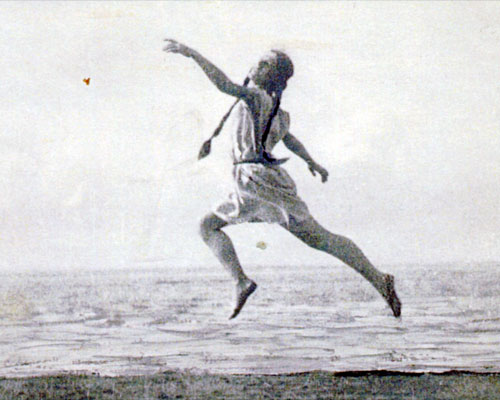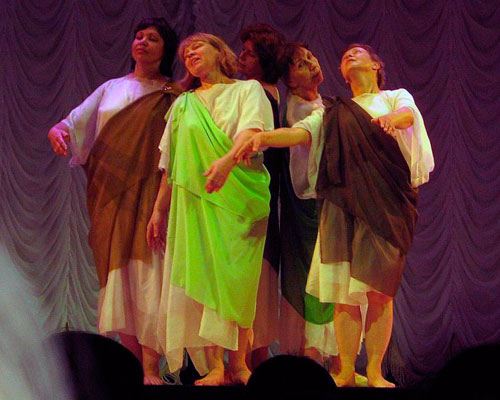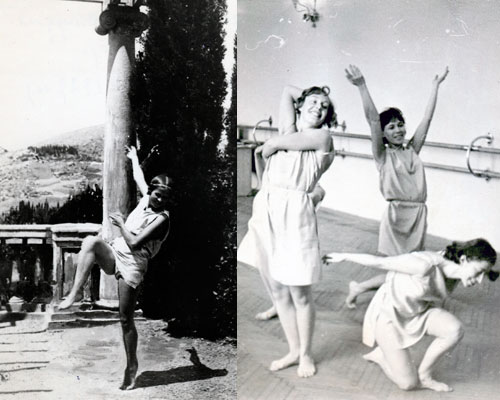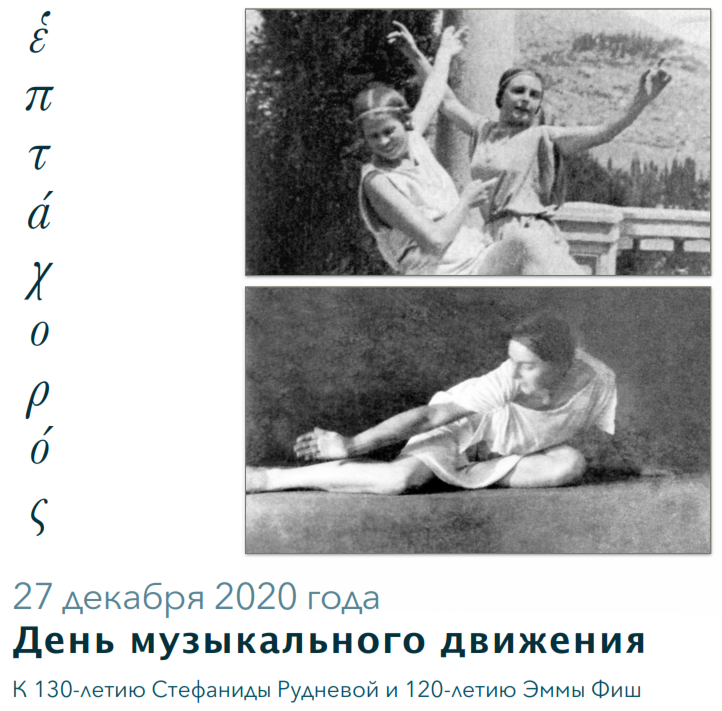Entry
In the heading “ Memories” there are several small fragments of Stephanida Rudneva’s lecture about Isadora Duncan, read to the dancer’s 100th birthday in 1977. Rudneva’s story is unique: she saw Duncan at the peak of her career, and not once, but many times. The sandal dance had such an impact on young Wall that her whole life changed in an instant, and this moment remained with her until the end of her life.Finally, in 1977, she judged Duncan’s technique and dance with full understanding, as her colleague in the workshop, she danced and taught “musical movement”. We hope to publish the most valuable memoirs of Stephanida Dmitrievna soon, but for now we are citing a few fragments from them.
Day of the Musical Movement To the 130th anniversary of Stephanida Rudneva and the 120th anniversary of Emma Fish
December 27, 2020. 15: 00-18: 00, Zoom.
For participation, please write to isiro25@gmail.com
The presentation of the site took place at the International Symposium “Stoking the Flame”,
held in London on August 1-4, 2019. See more in the Videos section.
Musical movement
Musical movement is a special form of art, where plastic, expressive movement arises from a spontaneous emotional response to music – so-called. dance “from music.” He was born during the work of the studio “Heptahor” (from the Greek word “hepta” – seven, “horos” – dance), formed in the early 20th century in St. Petersburg under the direction of Stefanida Dmitrievna Rudneva and six of her associates – graduates of the Higher Bestuzhev Courses. This studio left its descendants the main thing – the methodof musical movementwith detailed theoretical justification and rich methodical material (more than 300 exercises and sketches put on the best samples of classical and folk music ).
Improvisationis the initial component of the method. The process of such transformation is always creative, accompanied by uplifting
experiences (catharsis), transforming and the very personality moving.
The technique relies on naturaltypes of movement, walking, running, jumping, jumping; smooth, spring, swing, throw. Free, natural movements, which arise as impressions of sounding music, are based on relaxation and tension of the muscles of the body, proper breathing, awareness of impulse and inertia in movement.
Mastering the breathing technique (diaphragmatic, upper, full) and the technique of muscular feeling (from complete relaxation to complete tension) underlies the musical movement. Music is a living organism that breathes and experiences, and, moving out of music, mastering these techniques allows the whole body to perceive the period of music sounding (“from head to fingertips”) and to understand it from the inside. There is a deep immersion in the fabric of music, while everything is dancing: soul, body, mind, emotions, and imagination – your whole being.
A holistic approachis inherent in the method of musical movement, when a motor exercise is not unlearned from the very beginning, but is experiencedand lived in movement by everyone individually (sincerely, without visual effects), depending on physical and emotional abilities. That is why the individual experience and expression of the same piece of music by different dancers leads to the creation of compositions that are different from each other.
The most important component of expressive movement is the development of muscle sense (from complete relaxation to full tension of the body, parts of it or muscle group).
In the musical movement there are no standard poses and positions, except the main, the original rack, called S.D. Rudnev “stable unstable equilibrium” or “steady readiness to move” (comfortable position of the feet “heel together, socks apart by 30-45′) – with soft spring knees, with support on the front of the foot and moving the center of gravity of the body forward. Such a rack prepares the body to instantly respond to the first sounds of music. The holistic perception of music is facilitated by the abandonment of the practice of learning new exercises by individual parts of the body and from verbal accompaniment (in the form of comments and advice) during its sounding. In the musical movement, the music is not selected for a certain gymnastic design, and the movements are not selected to the music. They are born as if “flowing” out of it. Full immersion in music helps to avoid its reduced (dismembered) perception.
A holistic perception does not exclude theoretical analysis, but only after the sound of the music underlying any exercise or chosen for independent work. In the process of searching for a musical-motor image, the general nature of music or its parts, the movements themselves, the role of breathing, relaxation, tension, etc. are discussed. This is very important for the harmonization of logic and intuition in a person, his two principles – rational and emotional.
Music is the main one in music classes. The spectrum of music used is huge: classical and romantic, old, modern, jazz and folk. Those involved in the musical movement are given to understand any music and, most importantly, to move with it, understanding the differences, intonations, its character and nuances. In the classroom, there is always live music performed by a high-class accompanist.
The method of musical movement has a tried-and-tested theoretical and practical basis and uses special exercises: (a) training without music – RVC– the development of muscle feeling; b) breathing exercises; c) More than 300 exercises and sketches with music, divided into 3 stages in its complexity. Each exercise has a description in terms of music, movement and image. All the exercises are described by the founder of the musical movement S.D. Rudneva. Severaltextbooks on the music movement for classes with preschoolers and schoolchildren have been released, covering the exercises of the 1st stage. The materials of the 2nd and 3rd stages have not been published, and for the first time are published, as well as the materials of the 1st, in the facsimile version together with the notes on our website in the section “Methodacombe.”
All classes of the musical movement are emotionally colored and take place in a favorable psychologicalatmosphere. This enhances the work of various functions of the body, developing at the same time the Spirit – Body – Mind. The action of emotions can be compared with the action of physical forces – electric, magnetic. Different emotions have a different effect on a person’s energy expenditures. Positive emotions included in the classes on music movement, lead to a good mood and maximum efficiency from classes. And here is important not only the result of the activity, but also the process itself – it captures, captivates. Those who dance rise muscle tone scope,develops coordination, the ability to work in contact with others. Psychologists, neurophysiologists show that through muscle activity occurs intellectual development. Various types of perception (hearing, musical, periful, visual, motor) are amplified. creativeimagination and creative activity. Thus, the activity of the musical movement contributes to the flight of fantasy, spontaneous creative search, independent work on new musical works. The result of the classes are dance performances in the form of finished, highly artistic musical-motor images or new exercises.
The musical movement is not a frozen system of aesthetic education. Followers of the method preserve as historical value and pass on to the new generation the productions of A. Duncan’s studios, Heptahor and Look: Music! But over time and with the arrival of new teachers, this system acquires new interesting additions and findings. New exercises and compositions are born. And that’s a good thing, because what doesn’t develop then disappears.
Musical movement classes are available to everyone. These can be groups of children and parents with children, as well as women and men of any age, any physical fitness, any build. There is an interesting experience of working with pregnant women who danced from the first weeks of pregnancy to the very birth. After giving birth, one of the women came to classes with a two-week-old daughter in a “bag”, and later for several years in a row went with her to the women’s group. Musical movement classes are held, for example, at the Children’s English Musical and Plastic Theater. There is experience of working with children who often suffer from colds, bronchial asthma, and logoneurosis. Many studios operate in Moscow and St. Petersburg, where classes are conducted on the method of musical movement, thematic seminars, festivals, concerts and master classes are held (see the section on the history of MD).
For classes, you need a large (at least 50 m), clean, well-ventilated room. Floors should be smooth, splinter-free or hard carpeted. everyone dances barefoot. Musical movement presupposes good-sounding hardware and a well-tuned piano. For classes, shows and performances, light, natural fabrics are needed, from which tunics (chitons) are sewn and scarves are made.
The music movement helps to open up unexpected physical possibilities, new in the sphere of creativity, social, personal, individual and partnership. You will find new friends, learn to move freely, to control your body and emotions, to feel harmony in yourself, in life and the world around you, as confirmed by those who have passed this school, and those who continue to live in it.

















































